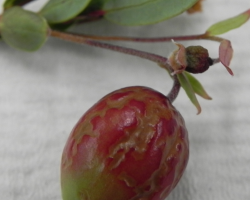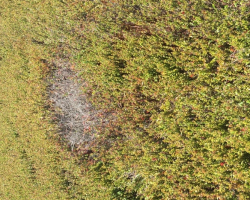Collecting Plant, Insect and Soil Material for Identification and Diagnosis (2018)
Hilary Sandler, Marty Sylvia, and Katherine Ghantous
UMass Cranberry Station, East Wareham, MA 02538
www.umass.edu/cranberry
Background
Collecting a good sample is key to getting an accurate diagnosis. This fact sheet will give you information on how to properly collect vine and other plants for assessment and diagnosis of different issues. Please include your name, phone number, date of collection, bog location and variety on every sample bag.
Disease diagnosis
- The ideal sample should represent the range of symptoms observed in the bed. Include plants that appear to be normal and symptomatic plants, ranging from best to worst.
- Remember to examine the entire plant. Even if symptoms appear to be aboveground
- (leaves, flowers, fruit, uprights), observe and include part of the root system in your sample. If you suspect Phytophthora, inclusion of roots is essential.
- If there are multiple affected areas, take separate samples from the different areas and/or beds. Make sure to label them. If you sample a bed that has two different varieties, keep the samples from each variety separate. The vines will be analyzed separately. Traditional diagnosis can take 1-2 weeks. In the future, diagnosis with ELISA kits may be conducted more quickly but we are just gearing up to use this method (2018).
- Make and record observations: make notes of the shape and size of the symptomatic area and note any distinct patterns in the bed (scattered, low spots, near edges, around sprinklers, variety affected, weeds also affects, etc.).
- Any pictures, additional information about management practices, history of the bed, and observations about when symptoms first appeared can be very useful in ruling out unrelated problems or finding the cause in a timely manner.
Phytophthora Root Rot
Collect from the margin of the affected area. Collect vines with roots attached. Do not collect or bring in dead vines. If you want roots analyzed for Phytophthora root rot, a sample of at least 40 infected vines (containing both uprights and roots) is necessary. To determine if the fungus is present, at least 40 root segments from the same number of underground runners must be plated. When possible, pull the vines up as opposed to cutting them out with a shovel, because the roots are the most important part of the sample. These plants should be gathered from the area of stressed vines adjacent to the dead vines. If several dead spots occur on a section of bed, sample from at least 10 areas and combine into one bag.
Upright Dieback
If you think you have upright dieback, bring in at least 50 uprights showing the symptoms. Keep samples from different cultivars separate. Uprights will be plated out for the causal agents to confirm the diagnosis.
Virus Detection (Tobacco Streak Virus and Blueberry Shock Virus)
Please bring in fresh samples (i.e., do not let them sit in a bag for several days). A sample should include 5-10 uprights with symptomatic fruit still attached. Virus symptoms are usually pretty easy to spot. Affected berries may have a red blush, purple, or brown color. Symptoms are most obvious in late June and throughout July. Scarred berries will turn color faster than healthy berries. Depending on staff availability, virus identification can take about 1 week to process and produce results.

 Weed Identification
Weed Identification
If you need to have a weed identified, it is important to bring in as many “plant parts” as you can (leaves, flowers, roots, fruit). Please try to keep the plant in one piece. Sometimes, being able to see how the plant connects to the ground is an important identifying point. Bring in 5-10 individual plants. Flowers are usually very helpful in identification. If you cannot bring the plants in right away, store them in a plastic zip bag in a cool place. A slightly damp paper towel can also be helpful to keep the sample in good shape; however, it is not necessary to keep the plant overly wet.
If you have a smart phone or a good camera, we can often identify the plant if you send us the image by email. Take a “long view” shot as well as a few close ups so we can see the flowers (if present), leaf arrangement, leaf margins, etc.
Send photos to: hsandler@umass.edu or kghantou@umass.edu
Insect Diagnosis
Generally, if you can collect several insects, store them in a sealed container for ID. Moths and beetles can be refrigerated or frozen before bringing in. Caterpillars should be given foliage to eat and kept cool.
Scale - Putnam Scale, Dearness Scale
Collect ~25 uprights that appear to have scale on them from the perimeter of the dead area. Do not collect from the dead area. Collect old wood as well as new growth as the scale seem to be more abundant there. Keep samples in a sealed plastic bag (if you can) until you can bring the sample to the Entomology lab.
Examples of different species of scale found on cranberry
Look for dark or white bumps on the upright’s stem, going down to the oldest woody part of vines. The bumps will be crunchy when crushed. If the insect is still alive, goo will come out. Empty scale covers often hang onto the stem, so it’s important to check for the live scales. Where the covers have come off, there may be white spots on the stem.

 Cranberry Tissue Samples
Cranberry Tissue Samples
We recommend tissue sampling every 2-4 years. Tissue samples should be collected when deficiency is suspected or diagnosis of a specific problem is needed. For problem diagnosis, collect 2 separate samples - one from the problem area, and one from nearby 'normal' vines.
Samples should NEVER contain roots, soil, runners, fruit, or trailing woody stems. Collect one composite sample for each management unit. Tissue samples are best collected from mid-August to mid-September. Samples collected at that time should include upright tips only (do not strip off the leaves). Collect no more than the top 2 inches of new growth (mix flowering and vegetative uprights). As you walk across the bog, collect 1 cup (at least 50 upright tips). You may collect directly into marked bags as samples should not be washed. Collect samples when the plants are not wet. Do not mail samples in plastic bags. Moldy samples give poor results. Always request nitrogen determination.
Sampling other than in August-September: Tissue samples may be collected at other times of the year, if absolutely necessary. However, nutrient levels change more rapidly outside of the recommended time and make interpretation of the results more difficult. If sampling in the spring, samples should be collected in June and consist of new upright tissue only. Do not include last season's leaves (this will lead to a falsely low result). Samples collected after mid-September give lower analysis values than those collected earlier. This is especially true for nitrogen (more stem tissue results in a lower value).
For further information regarding tissue testing, refer to a recent copy of the Cranberry Chart Book-Nutrition and/or the “Cranberry tissue testing for producing beds in North America” fact sheet (available at http://scholarworks.umass.edu/cranberry_factsheets/6/).
Soil Samples
Samples should NOT contain stems, leaves, or the surface duff layer (trash). These will bias the organic matter (OM) determination for the sample. The inclusion of some roots is generally unavoidable. Use a soil probe with a 1-2 inch diameter to collect cores of 4-6 inch depth. Minimum requirements: 4 cores for up to 1 acre; and 1 core for each additional 2 acres up to a total of 10 cores/management unit. After the trash layer on the surface of each is discarded, these cores are combined to make a sample. Collect enough soil to fill a 1-qt plastic bag about ¾ full. At home, open the bags and dry the soil at room temperature for a day or two. Clearly label each sample bag. OM determination (usually an additional charge) is often useful.
UMass provides soil and tissue analysis services at the Amherst lab for a fee. Submission forms and soil boxes are available at the Cranberry Station. Also see the UMass website for downloadable forms and schedule of fees (http://soiltest.umass.edu/). They use the Morgan test. However, the Bray test for soil Phosphorus (P) is the most commonly used in other labs for samples from the eastern United States. The Bray test, like all common P soil tests, is of limited value in cranberry soils. The best time to sample cranberry bogs is when the soil is not waterlogged. Wet soils give falsely high P values. Soil samples may be collected with tissue samples in the late summer if no sanding is planned. Otherwise, sample soil in the spring.
This work was supported in part by funding provided by USDA-NIFA Extension Implementation Program, Award No. 2017-70006-27137

